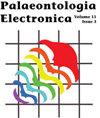美国德克萨斯州“Trinitichelys”maini (Testudinata: Baenidae)的订正及其新属补充资料(Woodbine Group, Cenomanian)
IF 2
4区 地球科学
Q1 Earth and Planetary Sciences
引用次数: 0
摘要
描述了贝尼龟“Trinitichelys”maini的新颅骨和颅骨后(包括壳和薄片)材料,并对该物种进行了分类修订,并将其归入新属Gehennachelys。maini的次类被扩展到包括信息丰富的标本,允许更全面的形态学理解和壳重建,以及更彻底的与同科的比较。在系统发育上,这个分类群被置于Baenodda的基部。Gehennachelys主梳。11 .缺乏对甲壳缘的最后方椎体鳞片和ω形股肛沟的贡献,尽管显示出Baenodda的衍生颅骨特征,但两者在历史上都被认为是Baenodda的突触型。这种不一致挑战了这些特征在诊断性别歧视中的效用,并突出了解决性别歧视关系中的问题。Gehennachelys证明baenodds早在Cenomanian中期就开始进化了,并且很可能在Cenomanian早期的退行中分散到阿巴拉契亚西南部,成为北美东部大陆的最终baenid。布伦特艾德里安。人类起源研究所,人类进化与社会变革学院,900 S. Cady Mall, Tempe, Arizona, 85287 USA。badrian@asu.edu Heather F. Smith。美国亚利桑那州格兰代尔市中西部大学59大道19555号解剖学系85308 USAhsmith@midwestern.edu克里斯托弗·r·诺托。威斯康辛大学帕克赛德分校生物科学系,美国威斯康辛州基诺沙53141noto@uwp.edu本文章由计算机程序翻译,如有差异,请以英文原文为准。
A revision of “Trinitichelys” maini (Testudinata: Baenidae) and additional material of its new genus from the Lewisville Formation (Woodbine Group, Cenomanian), Texas, USA
New cranial and postcranial (including shell and thin sections) material of the baenid turtle “Trinitichelys” maini is described and the species is taxonomically revised and referred to a new genus, Gehennachelys. The hypodigm of G. maini is expanded to include informative specimens allowing for a more comprehensive morphological understanding and shell reconstruction, as well as more thorough comparisons with confamilials.This taxon is phylogenetically placed at the base of Baenodda. Gehennachelys maini comb. nov. lacks a contribution of the posteriormost vertebral scale to the carapace margin and an omega-shaped femoral-anal sulcus, both historically regarded as baenodd synapomorphies, despite showing derived cranial characters for Baenodda. This inconsistency challenges the utility of these traits in diagnosing baenodds and highlights problems in resolving baenid relationships. Gehennachelys demonstrates that baenodds evolved as early as the middle Cenomanian, and it likely dispersed to southwestern Appalachia during a regression in the early Cenomanian, becoming the terminal baenid from the eastern North American landmass. Brent Adrian. Institute of Human Origins, School of Human Evolution and Social Change, 900 S. Cady Mall, Tempe, Arizona, 85287 USA. badrian@asu.edu Heather F. Smith. Department of Anatomy, 19555 N. 59th Avenue, Midwestern University, Glendale, Arizona 85308 USA. hsmith@midwestern.edu Christopher R. Noto. Department of Biological Sciences, University of Wisconsin Parkside, Kenosha, Wisconsin, 53141, USA. noto@uwp.edu
求助全文
通过发布文献求助,成功后即可免费获取论文全文。
去求助
来源期刊

Palaeontologia Electronica
地学-古生物学
CiteScore
3.60
自引率
0.00%
发文量
20
审稿时长
>12 weeks
期刊介绍:
Founded in 1997, Palaeontologia Electronica (PE) is the longest running open-access, peer-reviewed electronic journal and covers all aspects of palaeontology. PE uses an external double-blind peer review system for all manuscripts. Copyright of scientific papers is held by one of the three sponsoring professional societies at the author''s choice. Reviews, commentaries, and other material is placed in the public domain. PE papers comply with regulations for taxonomic nomenclature established in the International Code of Zoological Nomenclature and the International Code of Nomenclature for Algae, Fungi, and Plants.
 求助内容:
求助内容: 应助结果提醒方式:
应助结果提醒方式:


